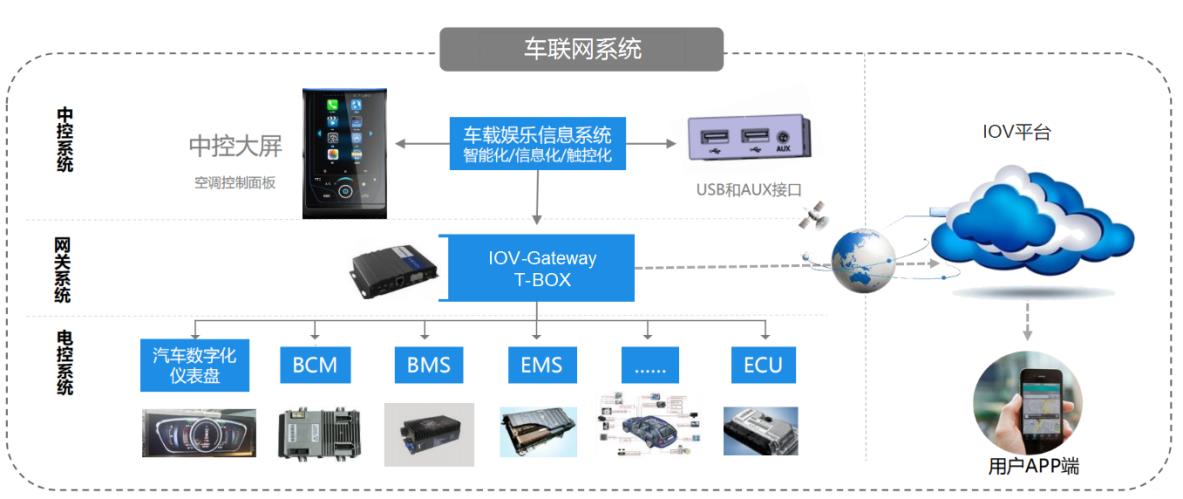How is the car networking system structured?
The key function of the car networking technology is the driver, who can remotely control the car and monitor the safety of the car through mobile devices. Therefore, the car networking platform and the user’s APP form a complete car networking system.

In 1996, General Motors cooperated with Motorola Motor Company to launch the first networked car equipped with OnStar system. By using OnStar’s push-to-talk voice calling function, the owner will route the call to the call center in case of road emergency, so that professional staff can arrange emergency rescue. With the passage of time, the technology of car networking has been continuously upgraded, and it has gradually matured until today.
A typical example:
Car owners need to check whether the car can be locked when they leave the parking space. The car networking system enables car owners to ensure that their doors are locked by simply accessing the application on their mobile phones.
The key function of the car networking technology is the driver, who can remotely control the car and monitor the safety of the car through mobile devices. Therefore, the car networking platform and the user’s APP form a complete car networking system.

Each vehicle is connected to the vehicle networking system as an independent individual. The central control system, gateway system and electronic control system of the vehicle are the important hardware foundation of the vehicle networking. The central control system, gateway system and electronic control system are mainly composed as follows:
- Central control system:Air conditioning control system, vehicle entertainment information system, vehicle navigation and positioning system;
- Gateway system:T-Box (mainly including GPS/AGPS, SIM and some low-power GPS with its own power supply);
- Electronic control system:Automobile digital instrument, body control module BCM, battery management system BMS, driving computer ECU, engine management system EMS…… …
The main functions of the vehicle networking platform include vehicle information management, vehicle monitoring, vehicle control and statistical analysis of vehicle data.
- Information management:Model, T-Box, battery, sensor, SIM card, etc.
- Vehicle monitoring:Location, fault, CAN data, etc.
- Vehicle control:Control of car locks, doors, lights, windows, etc.
- Statistics:Speed, power, mileage, fault, etc.
The user APP can directly interact with the data of the car networking platform, or transfer the data to the car networking platform through a third-party business platform. The main function of the user APP is vehicle control, and the body system of car locks, doors, lights and windows is controlled.
The vehicle-mounted device controller and the vehicle-mounted T-Box form a local area network, and the vehicle-mounted T-box can access the Internet, so the vehicle-mounted device, the vehicle networking platform and the user’s mobile phone APP can interact with each other.
(1)CAN BUS
- High-speed CAN bus:The speed can reach 500kb/s, and the transmission information is large and the speed is fast. It is used to drive the system, and it is mainly connected with the driving system such as engine control unit, ABS control unit, airbag control unit and instrument cluster.
- Low speed CAN bus:The speed is 100kb/s, which is used in the car body system, and it is mainly connected with the car body system that does not require high data transmission rate, such as central locking, electric doors and windows, rearview mirror and interior lighting.
At present, the CAN bus connection modes in automobiles mainly include high-speed and low-speed CAN buses. In addition, there are some buses such as entertainment systems or intelligent communication systems in middle and high-class cars, and their transmission rates are higher, which can exceed 1 MB/s.
(2)OBD
OBD can monitor engine, catalytic converter, particulate trap, oxygen sensor, emission control system, fuel system, EGR and other systems and components.
- The OBD is connected to the electronic control unit ECU through various components information related to emissions, and the ECU can detect and analyze emissions-related faults;
- When there is an emission fault, ECU records the fault information and related codes, and sends out a warning through the fault light to inform the driver;
- ECU ensures the access and processing of fault information through standard data interface.
(3)I/O hardware
I/O hardware control vehicle is a part of the system that controls the vehicle by closing the relay, which is mainly used to modify the vehicle. Because the CAN protocol of the vehicle main engine factory can’t be obtained, we can only modify the vehicle, use T-Box to directly connect with some systems, and control the relay in the middle.
The vehicle-to-vehicle networking platform can connect the vehicle-mounted T-Box to the Internet through the 2G, 3G and 4G network cards installed on the T-Box, and report the real-time state data of the vehicle to the vehicle-to-vehicle networking platform in the form of messages, and the vehicle-to-vehicle networking platform also actively issues instructions to the T-Box to control the vehicle.
(1) The uplink data reported by the vehicle to the vehicle networking platform includes vehicle status (vehicle status, operation mode, vehicle speed, mileage, gear position, accelerator pedal stroke value and brake pedal status), positioning data (longitude, latitude, speed, etc.), BCM status (central locking, trunk, window, lights, horn, door and other body parts) and EAS status (air conditioning status, AC).
The methods of reporting data mainly include:
- Periodically, T-Box actively reports the state data of vehicles at regular intervals;
- Trigger reporting, when some state data of the vehicle changes, T-Box reports the vehicle data, for example, when the vehicle starts;
- Immediately call for reading, the vehicle networking platform actively inquires about the data, issues the command to obtain the data, and the T-Box immediately feeds back the vehicle status data;
- Feedback reporting: after the control command is issued through the vehicle networking platform, the execution result of the command is fed back.
(2) Downlink instructions issued by the vehicle networking platform to vehicles mainly include vehicle control (switch control of doors, windows, air conditioning, central control, lights, trunk, motor, etc.) and air conditioning control (switch, wind speed, cold and hot, wind direction, air volume, etc.), which are divided into the following three steps:
- The vehicle networking platform sends instructions to the t-box;
- T-Box sends instructions to the vehicle system;
- The execution result is fed back to the vehicle networking platform.
At present, users can directly interact with the car networking platform through the mobile APP, or interact with an independent business platform first, and then the business platform interacts with the car networking platform. This method is mostly used for time-sharing leasing. The user can issue control instructions for the vehicle and the acquired state data of the vehicle.
(1) Control instruction
Users control vehicles through APP, mainly including locks, doors, windows, trunks and air conditioners.
(2) Status data
The user needs to obtain the state data of the vehicle mainly including the real-time state of the lock, door, window, trunk and air conditioner and the feedback information of the result of issuing control instructions.
Bluetooth communication between vehicle and mobile phone mainly prevents the vehicle from controlling the vehicle by mobile phone through the network in the scene of no signal, so Bluetooth communication between vehicle and mobile phone mainly realizes the door lock control and start authorization of the vehicle.
(1) Static binding
Static binding is suitable for the use of private cars, and one-to-one long-term binding of mobile phones and vehicles.
- When vehicle information is entered on the vehicle networking platform, the Bluetooth information and MAC address of the mobile phone are entered, and the information is sent to the vehicle-mounted T-Box, and the vehicle-mounted Bluetooth information is sent to the mobile phone, thus completing the Bluetooth binding between the vehicle and the mobile phone.
- The mobile phone applies to bind the car Bluetooth, sends the mobile phone Bluetooth information and Mac address to the car networking platform, and then the car networking platform forwards it to the car T-box, and sends the car Bluetooth information entered into the car networking platform in advance to the mobile phone to complete the Bluetooth binding between the mobile phone and the vehicle.
(2) Dynamic binding
- When the vehicle-mounted SIM card has a signal, the mobile phone applies to bind the vehicle-mounted Bluetooth, sends the mobile phone Bluetooth information and Mac address to the vehicle networking platform, which then forwards it to the vehicle T-box, and sends the vehicle-mounted Bluetooth information entered into the vehicle networking platform in advance to the mobile phone, thus completing the Bluetooth binding between the mobile phone and the vehicle;
- When there is no signal from the car SIM card, the mobile phone applies for binding the car Bluetooth, and sends the mobile phone Bluetooth information and Mac address to the car networking platform, which forwards it to the car T-box, but it is unacceptable. At this time, the Bluetooth pairing information stored in the car networking platform and generated by the last car can be sent to the user’s mobile phone to complete the Bluetooth binding between the mobile phone and the car. In this way, every time the Bluetooth pairing information is used, a new pairing information is generated.
A few decades ago, you might not have imagined the Internet of Things in your life or the connected cars running on the highway.
However, today, the car, the car networking platform, the user APP and the data interaction among them form a complete car networking system. All this is happening now, and the future days are full of many possibilities. We have reason to believe that the Internet of Things will have a great impact on the automobile industry, mobile Internet enterprises and consumer groups.
This article was originally published by @ Dream by Dream. Everyone is a product manager. Reprinting is prohibited without permission.
The title map comes from Unsplash and is based on CC0 protocol.